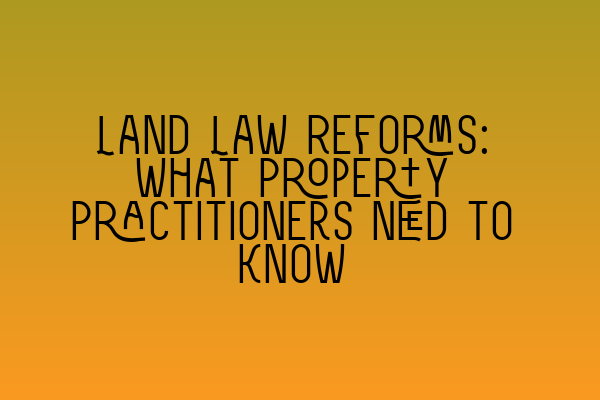Land Law Reforms: What Property Practitioners Need to Know
In the dynamic field of property law, staying updated with the latest reforms and changes is crucial for property practitioners. The landscape of land law is constantly evolving, with new legislation and case law shaping the rights and obligations of property owners and occupiers.
In this blog post, we will discuss some of the recent land law reforms that property practitioners should be aware of. Whether you are a solicitor, conveyancer, or other legal professional involved in property transactions, this information will help you navigate these changes effectively.
The Leasehold Reform
One of the significant land law reforms that has gained attention in recent years is the leasehold reform. The government has taken steps to address the concerns around unfair leasehold practices, particularly in relation to new build properties.
Under the leasehold reform, property practitioners should be familiar with the following key points:
- Ground Rent: The government has proposed a ban on new leasehold homes being sold with a ground rent. This aims to prevent homeowners from being subject to escalating ground rents in the future.
- Lease Extension: Leaseholders now have the right to extend their lease by up to 990 years, removing the need to pay ground rent.
- Right to Buy: Leaseholders of houses will have the right to buy the freehold of their property. This will give them greater control and eliminate leasehold charges.
- Commonhold: The government is exploring the introduction of commonhold as an alternative to leasehold. This would allow homeowners to own their property outright and have shared responsibility for communal areas.
For more in-depth information on leasehold reform, you can read our article on Misrepresentation in Contracts: Unveiling Deceptive Practices.
Electronic Conveyancing
The digital revolution has also made its way into property law, with the introduction of electronic conveyancing. This reform aims to streamline the conveyancing process and make it more efficient by digitizing land registration and deed transfers.
As a property practitioner, it is essential to adapt to the changing landscape of conveyancing. Some key aspects of electronic conveyancing include:
- Online Land Registration: The move towards online land registration means that property transactions can now be completed digitally, reducing the need for physical documents.
- Electronic Signatures: The use of electronic signatures is becoming increasingly common in property transactions, allowing parties to sign documents remotely and securely.
- Digital ID Verification: Property practitioners need to ensure they are using reliable methods for digital ID verification to authenticate the identity of parties involved in a transaction.
- Data Security: With the increased reliance on digital systems, property practitioners must implement robust data security measures to protect sensitive client information.
To delve deeper into electronic conveyancing, our article on A Closer Look at SQE Contract Law Syllabus provides insight into the syllabus topics related to this area.
Planning Law Changes
Property practitioners must also be aware of the recent changes in planning law. These reforms aim to streamline the planning process and provide greater certainty to developers and property owners.
Here are some key points to be familiar with:
- Permitted Development Rights: The government has expanded permitted development rights, allowing certain changes and extensions to be made to properties without requiring planning permission.
- Use Classes Order: Planning regulations have been simplified with the introduction of a new use classes order, making it easier to change the use of commercial premises without seeking planning permission.
- Community Infrastructure Levy (CIL): Changes have been made to the CIL regulations, affecting the financial contributions developers need to make towards local infrastructure projects.
- Building Safety: Following the Grenfell Tower tragedy, new regulations have been introduced to improve building safety, particularly in relation to high-rise residential buildings.
For a comprehensive understanding of planning law, our article on SQE Contract Law: Analyzing Landmark Cases and Influential Judicial Decisions provides a valuable insight into the legal principles and cases shaping this area of law.
Conclusion
As property practitioners, staying informed about land law reforms is essential to provide effective advice and services to clients. The leasehold reform, electronic conveyancing, and planning law changes are just a few examples of the reforms that property practitioners need to be familiar with.
For a more comprehensive understanding of property law and to test your knowledge, we recommend checking out our article on Understanding Contractual Capacity: Rights and Limitations and taking our interactive SQE mock tests for contract law.
By keeping up-to-date with these reforms and continuing professional development, property practitioners can confidently navigate the complex landscape of land law and effectively represent their clients’ interests.
